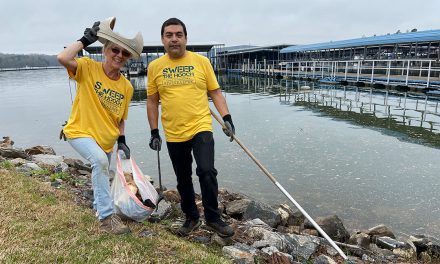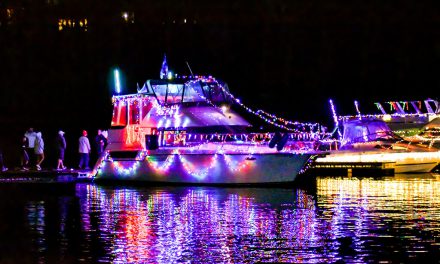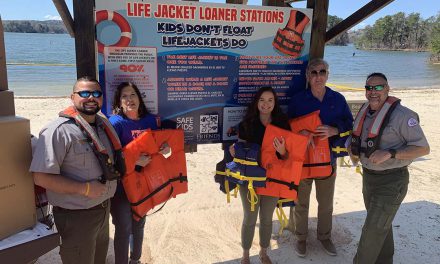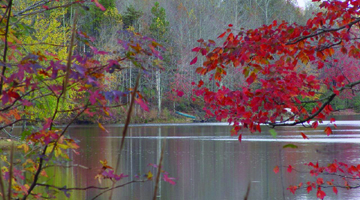Lakeside’s Senior Reporter Pamela A. Keene recently returned from an African Safari. Here is her first installment of a two-part series describing the fascinating journey that offered up a surprise or two.
They’re called the Big Five – lions, leopards, elephants, rhinoceros and cheetahs – and travelers to Africa doggedly seek them on safari. However, if that’s your reason for traveling to the Southern Hemisphere on a 17-hour non-stop flight from Atlanta to Johannesburg, you’re missing the point of this incredible adventure.
Certainly, the mammals and birds – painted dogs, lilac-breasted rollers, cape buffalo, hippopotamus and giraffes – cause the heart to beat faster and the camera shutters to click at record speed, but journeying with Overseas Adventure Travel digs deeper. Meeting villagers doing their daily chores, visiting with school children on holiday who came to see the Americans, and hearing from game officials dedicated to apprehending poachers that threatened wildlife elevated our 16-day trek through Zimbabwe, Zambia and Botswana to the highest level.
The photos tell the story, but so did our Program Director Armstrong Siyawareva, who has been leading photo safaris for more than a decade and knows the secrets of the African bush. He also knows the best place to get an amazing hamburger, how to truly enjoy sundowners, and what to do if you lose your iPhone while viewing lions. Don’t jump out of the safari jeep!
The exploration begins
As the capital of South Africa, Johannesburg is a big city, called Jo-burg by locals. Arriving a day early, Rick and I arranged a tour of the district of Soweto where both Desmond Tutu and Nelson Mandela lived at different times. The short street was filled with vendors, tribal entertainers and a smattering of tourists.
Tutu’s home, now owned privately, isn’t open to tours, but Mandela’s humble red-brick home details his 27-year imprisonment for anti-colonial activism, his release in 1990, and his rise to the country’s presidency from 1994-1998. His life-long dedication to human rights made him an international influence until his death at age 95 in December 2013.
Without realizing it, our visit to Soweto provided our first glimpse of the complicated lives of the people across these four countries of southern Africa. Many people go to this part of the world to see the Big Five and other wildlife, but for us, our eyes were opened to the disparate cultures, politics and people we would experience over the next 15 days.
Fourteen of us boarded a plane from Jo-burg to Victoria Falls, a small but teeming town known for the massive Victoria Falls, the world’s largest waterfall. All we got was a taste of its massive presence through the window of the plane where the mist constantly rises above the horizon, and another from the van window as we headed to Zimbabwe, and our first of four safari camps.
Hwange National Park several hours’ drive gave Armstrong a chance to introduce us to his home country, which he called Zim, with its extensive mineral mining, mostly gold. Along the way, glimpses of people along the dusty and bumpy highway began to unveil the reality of life here.
We stopped for several women selling nuts from woven baskets. For $2, they would be able to feed their children for several weeks. “For them, $2 is a great deal of money,” he explained. He also revealed that the unstable economy in Zim has been devasting for the country, at one point experiencing an inflation rate of 1,500 percent in one year.
The drive deep into the bush took us to our first camp, arriving after sunset. The Southern Cross and Orion guided our way. Our hosts at Makalolo Tented Camp had prepared our evening fire, which was a tradition in each of our camps; after dinner, we retired to our tents to prepare for the next day’s early-morning game drive.
A note about tent camps: Permanent tents of heavy canvas, furnished with real beds and furniture, plus bathrooms that included hot-and-cold running water for showers and flushing toilets outshined what many people in the US called glamp sites. Some had electricity and air-conditioning; others relied on fans for cool air at night.
Getting up before the sun every day became routine and rewarding. After a light breakfast of cereal, fruit, coffee and tea, we boarded two safari jeeps with open multi-level seating. The back seats afforded excellent viewing and photography. We were on the road in the dark most mornings.
The African bush habitats can keep wildlife hidden, but on our first morning, four lionesses came walking down a dirt road, ignoring our two jeeps. “Don’t move suddenly, and don’t try to pet them,” our driver cautioned as one lion passed within five feet of a jeep. “They see the jeep – and you – as a large object, but not prey. You’re safe.” He was right.
We trailed the lions as they focused on a lone wildebeest several hundred yards away near a watering hole, waiting for the right time to sprint and capture what would be a meal for the males first, then the cubs and then for themselves. After almost two hours, the lions appeared to lose interest, and we moved on.
Each morning’s game drive begins before dawn with temperatures in the high 40s. We bundled in layers, peeling them off as the morning progressed. Drives lasted about 3-4 hours each, and along the way our drivers and guides set up a morning break for coffee, tea, hot chocolate and cookies or pastries.
Back at the camp by 11 or 11:30, brunch was served. Our midday meal could range from eggs, bacon and polenta, which tasted like grits but was smoother, to baked chicken, mac-and-cheese and fresh veggies.
By 3 p.m. it was time for afternoon tea: hot or cold beverages with savory and sweet finger foods. Time for socializing, comparing notes and photos and just getting to know our fellow travelers was always part of the day.
Afternoon game drives began right after tea and extended to after sunset. “The animals are the most active during the early morning and late afternoon to dusk,” Armstrong explained.
We relied on the keen eyes of our guides and drivers to spot individual or small groups of giraffes, wildebeests, impala, jackal, elephants with babies and teens, baboons and zebra. After a couple of days, we became accustomed to signs, such as movement in the tall grasses or bush, the flash of a bird or a “bump” in the horizon that signaled tall giraffes nearby.
Watering holes provide natural gathering places for the many mammals, reptiles, amphibians and birds of the bush. In Zim, conservationists created some of the watering holes by tapping into underground water sources and using pumps to bring the water to the surface.
Three nights at Makalolo went quickly. On the way to our next camp, we visited a Hwange village in Zim and met with residents. A stop at nearby Mizpah School, which is supported by the Grand Circle Foundation, revealed work being done through traveler’s donations to Grand Circle Travel and Overseas Adventure Travel to install clean water systems, permanent bathrooms, school buildings and more.
Pupils studied math, science and learned English. They also created a school garden with tomatoes, squash, cabbages and other vegetables used for on-grounds lunches. Typically, education in these countries is free from grades 1-7. Often boys continue, but girls drop out because their parents can’t afford to pay.
As we left Zim, we boarded two small airplanes to continue our journey to three more tented safari camps and a final stop before heading home.

Armstrong Siyawareva
Program director’s ‘Armstrong-isms’ and insights
Throughout our journey, Program Director Armstrong Siyawareva shared insights and memorable phrases:
ALTs: We saw many animals that turned out to be “animal-looking things,” otherwise called ALT. Tree branches, termite mounds, floating logs and the like can be deceiving.
Monkey business: We had lunch with the monkeys. While eating a picnic under a large tree, a small Werner monkey skittered down from the tree and stole my sandwich right from my hand.
Nature calls: On safari, a “pit stop” could be called “a loo with a view” or the “toilet-trees are waiting.”
Meal time wish: Wishing diners a pleasant meal, “bon appetit” became “baboon up a tree.”
Nature’s recycling: Elephant dung has many uses – repellent for Tsetse flies when burned in a special container at the back of the safari jeep; undigested remains include whole nuts that smaller animals eat; and habitat for insects.
Wisdom: Only a wise man will plant a tree and never see its shade.
Next installment: The adventure continues to Zambia, Botswana and Victoria Falls.
Photos: by Pamela A. Keene







